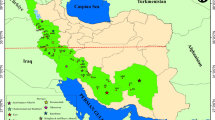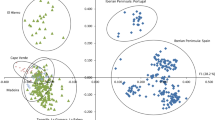Abstract
Prunus cerasoides D. Don has been identified as an excellent ‘framework tree species’ for restoring evergreen forest in seasonally dry tropical forestlands. Here we describe the level of microsatellite variation in P. cerasoides trees within and among three National Parks in northern Thailand: Doi Suthep-Pui, Doi Inthanon and Doi Ang Khang, using published primers developed for peach, sweet cherry and sour cherry. The five microsatellite loci employed detected a total of 41 alleles, with the average number of alleles per locus per study site ranging from 2.7 to 8.0 (n = 82). The value of F ST over the three sites was 0.115, indicating that while the majority of genetic diversity may be contained within sites, they should be considered as genetically distinct. The implications of this for seed collection of this species for forest restoration are discussed.
Similar content being viewed by others
References
Aldrich P.R., Hamrick J.L., Chavarriaga P. and Kochert G.1998. Microsatellite analysis of demographic genetic structure in fragmented populations of the tropical tree Symphonia globulifera. Mol. Ecol.7: 933–944.
Barrett S.C.H., Kohn J.R. and 1991. Genetic and evolutionary consequences of small population size in plants: implications for conservation. In: Falk D.A. and Holsinger K.E. (eds.) Genetics and Conservation of Rare Plants. Oxford University Press, Oxford, pp. 3–30.
Blakesley D., Anusarnsunthorn V., Kerby J., Navakitbumrung P., Kuarak C., Zangkum S., Hardwick K. and Elliott S., 2000. Nursery technology and tree species selection for restoring forest biodiversity in northern Thailand. In: Elliott S., Kerby J., Blakesley D., Hardwick K., Woods K. and Anusarnsunthorn V. (eds.) Forest Restoration for Wildlife Conservation. International Tropical Timber Organisation and The Forest Restoration Research Unit, Chiang Mai University, Thailand, pp. 207–220.
Brown A.H.D. and Marshall D.R.1995. A basic sampling strategy: theory and practice. In: Guarino L., Ramanath Rao V. and Reid R. (eds.) Collecting Plant Genetic Diversity (Technical guidelines). CAB International, Wallingford, 748 pp.
Cantini C., Iezzoni A.F., Lamboy W.F., Boritzki M. and Struss D.2001. DNA fingerprinting of tetraploid cherry germplasm using simple sequence repeats. J. Am. Soc. Hort. Sci.126: 205–209.
Cipriani G., Lot G., Huang W.-G., Marrazzo M.T., Peterlunger E. and Testolin R.1999. AC/GT and AG/CT microsatellite repeats in peach [Prunus persica (L.) Batsch]: isolation, characterisation and cross-species amplification in Prunus. Theor. Appl. Gen.99: 65–72.
Downey S.L. and Iezzoni A.F.2000 Polymorphic DNA markers in black cherry (Prunusserotina) are identified using sequences from sweet cherry, peach and sour cherryJ. Am. Soc. Hort. Sci.125: 76–80.
Elliott S., Navakitbumrung P., Kuarak C., Zangkum S., Blakesley D. and Anusarnsunthorn V.2001. Testing framework tree species for restoring biodiversity on degraded forestland in northern Thailand. Proceedings of the tropical forest symposium: the art and practice of conservation planting.
Elliott S., Kuarak C., Navakitbumrung P., Zangkum S., Anusarnsunthorn V. and Blakesley D., 2002. Propagating framework trees to restore seasonally dry tropical forest in northern Thailand. New Forests. 23: 63–70.
FAO1995. State of the world's forests.
Forest Restoration Research Unit. 1998. Forests for the future: growing and planting native trees for restoring forest ecosystems. Elliott, S., Anusarnsunthorn V. and Blakesley D. (eds.), 60 pp.
Forest Restoration Research Unit. 2000. Tree seeds.and seedlings for restoring forests in northern Thailand. Kerby J., Elliott S., Blakesley D. and Anusarnsunthorn V. (eds.) Biology Department, Science Faculty, Chiang Mai University, Thailand, 152 pp.
Frascaria N., Santi F. and Gouyon P.H.1993. Genetic differentiation within and among populations of chestnut (Castanea sativa Mill.) and wild cherry (Prunus avium L.). Heredity70: 634–641.
Godoy J.A. and Jordano P.2001. Seed dispersal by animals: exact identification of source trees with endocarp DNA microsatellites. Mol. Ecol.10: 2275–2283.
Goosem S.P. and Tucker N.I.J.1995. Repairing the rainforest — theory and practice of rainforest re-establishment in north Queensland's wet tropics. Wet Tropics Management Authority, Cairns, 71 pp.
Guarino L.1995. Assessing the threat of genetic erosion. In: Guarino L., Ramanath R.V. and Reid R. (eds.) Collecting plant genetic diversity (Technical guidelines). CAB International, Wallingford, 748 pp.
Hedrick P.W.2001. Conservation genetics: where are we now?Trends Ecol. Evol.16: 629–636.
Hokanson S.C., Szewc-McFadden A., Lamboy W. and McFerson J.1998. Microsatellite (SSR) markers reveal genetic identities, genetic diversity and relationships in a Malus×domestica Borkh. core subset collection. Theor. Appl. Genet.97: 671–683.
Joobeur T., Periam N., de Vicente M.C., King G.J. and Arús P., 2000. Development of a second generation linkage map for almond using RAPD and SSR markers. Genome43: 649–655.
Jordano P.and Godoy J.A.2000. RAPD variation and population genetic structure in Prunus mahaleb (Rosaceae), an animal dispersed tree. Mol. Ecol.9: 1293–1305.
Lamb D., Parrotta J., Keenan R. and Tucker N.I.J.1997. Rejoining habitat remnants: restoring degraded rainforest lands. In: Laurence W.F. and BierrgaardJr., R.O. (eds.) Tropical forest remnants: ecology, management and conservation of fragmented communities. University of Chicago Press, Chicago, IL, pp. 366–385.
Mariette, S., Lefranc M., Legrand L., Taneyhill D., Frascaria-Lacoste N. and Machon N.1997. Genetic variability in wild cherry populations in France. Effects of colonizing processes. Theor. Appl. Genet.94: 904–908.
Marshall, D.R. and Brown A.H.D.1975. Optimum sampling strategies in genetic conservation. In: Frankel O.H. and Hawkes J.G. (eds.) Crop genetic resources for today and tomorrow. Cambridge University Press, London, pp. 53–80.
Murray, M.G. and Thompson W.F.1980. Rapid isolation of high molecular weight plant DNA. Nucleic Acid Res.8: 4321–4325.
Nauta, M.J. and Weissing F.J.1996. Constraints on allele size at microsatellite loci: implications for genetic differentiation. Genetics143: 1021–1032.
Pemberton, J.M., Slate J., Bancroft D.R. and Barrett, J.A.1995. Non-amplifying alleles at microsatellite loci: caution for parentage studies. Mol. Ecol.4: 249–252.
Raymond, M. and Rousset F.1995. GENEPOP (version 1.2): population genetics software for exact tests and ecumenicism. J. Heredity86: 248–249.
Sambrook, J., Fritsch E.F. and Manniatis J.1989. Molecular cloning. A laboratory manual. Cold Spring Harbour Laboratory Press, New York.
Santi, F.1988. Variabilité génétique intra et interpopulations chez le Mersier (Prunus avium L.). Thèse Docteur de l'Institut National Agronomique Paris-Grignon, INA-PG.
Schmidt, L.2000. Guide to handling of tropical and subtropical forest seed. Danida Forest Tree Centre, Denmark.
Sosinski, B., Gannavarapu M., Hager L.D., Beck L.E., King G.J., Ryder C.D., Rajapakse S., Baird W.V., Ballard R.E. and Abbott, A.G.2000. Characterisation of microsatellite markers in peach [Prunus persica (l.) Batsch]. Theor. Appl. Genet.101: 421–428.
Tucker, N.I.J. and Murphy T.M.1997. The effects of ecological rehabilitation on vegetation recruitment: some observation from the wet tropics of north Queensland. For. Ecol. Manage.99: 133–152.
Weber, J.L.1990. Informativeness of human (cC-dA) n (dG-dT)n polymorphisms. Genomics7: 524–530.
Weber, J.L. and May P.E.1989. Abundant class of human DNA polymorphisms which can be typed using the polymerase chain reaction. Am. J. Human Gen.44: 388–396.
Wright, S.1965. The interpretation of a population structure by F-statistics with special regard to systems of mating. Evolution19: 395–420.
Author information
Authors and Affiliations
Corresponding author
Rights and permissions
About this article
Cite this article
Pakkad, G., James, C., Torre, F. et al. Genetic variation of Prunus cerasoides D. Don, a framework tree species in northern Thailand. New Forests 27, 189–200 (2004). https://doi.org/10.1023/A:1025010403477
Issue Date:
DOI: https://doi.org/10.1023/A:1025010403477




